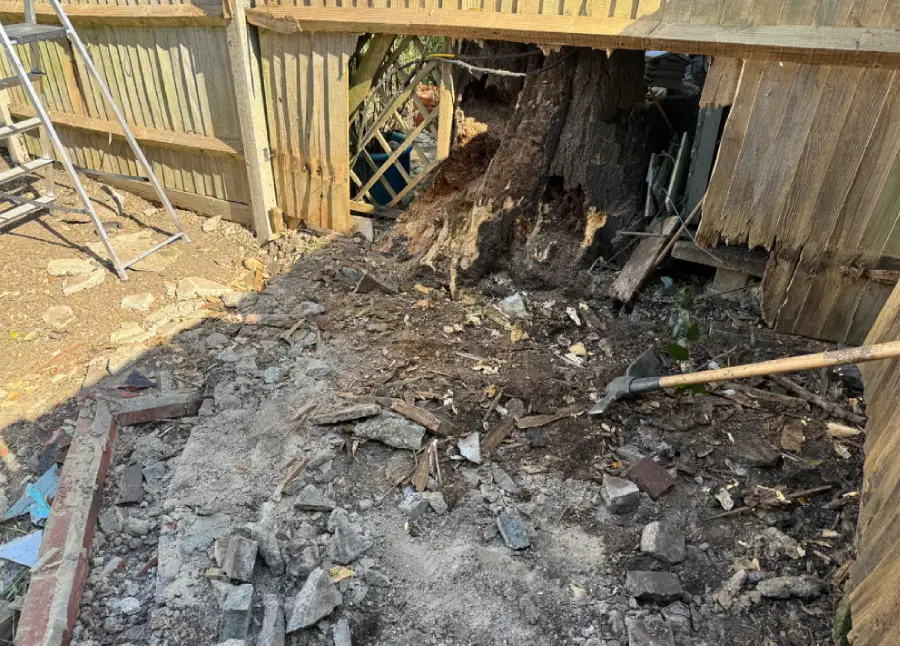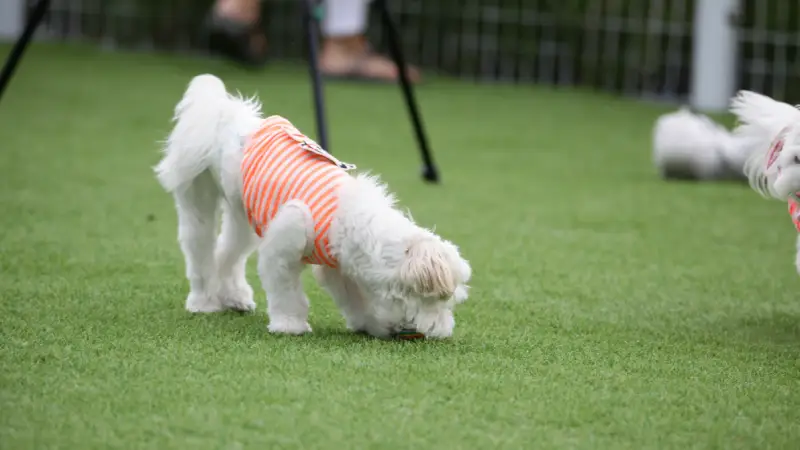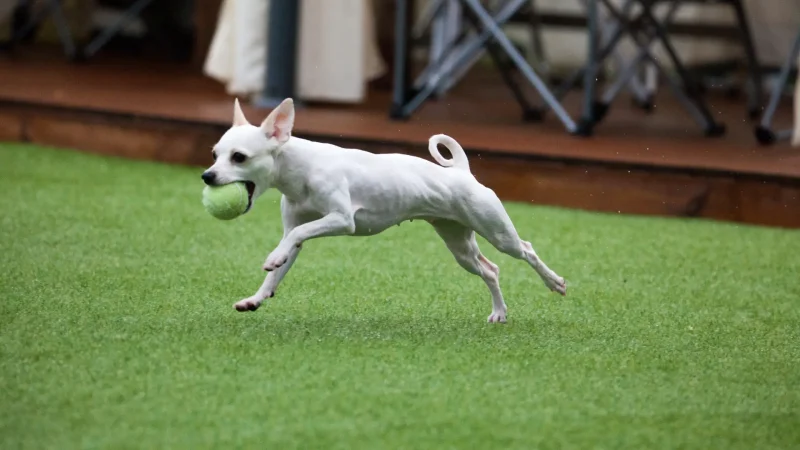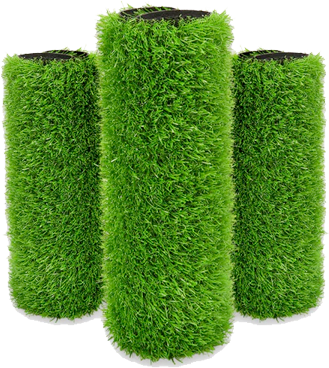Torn between your dog and your once-beautiful lawn?
You love your furry friend, but the yard?
It’s full of muddy patches, urine stains, torn-up grass, and even fleas. And after every play session, it’s another bath and another clean-up.
Well, we understand this pain. Therefore, here is a complete guide to the pros and cons of artificial grass with dogs. It will help you to find a solution that works for both your pet and your lawn.
Let’s dive in!
Table of Contents
TogglePros: What are the benefits of artificial grass for dogs?

1. No More Mud-Stained Floors or Soggy Paws
You let your dog out for five minutes.
He comes back with muddy paws that streak across your floors, couch, and — yep — your bedsheets.
Artificial turf eliminates mud entirely. No soil, no mess, no surprises.
Just clean paws, every time.
Here’s what Claire (mum of two Labradors) said,
“We thought we needed a better vacuum. Turns out, we just needed a yard that didn’t turn into a swamp every time it rained.”
2. Flea-Free, Tick-Free, and 100% Chemical-Free
Real grass is a breeding ground for fleas, ticks, and pollen allergens.
Artificial turf offers a clean, pest-resistant surface that doesn’t require fertilisers or harsh chemicals.
So your dog can roll, sniff, and nap without absorbing toxins through their paws or coat.
Also Read: Why Should You Get Synthetic Turf?
3. Looks Gorgeous Year-Round — No Matter What Your Dog Does
Forget brown patches, uneven spots, and the guilt of a lawn that always looks “just okay.”
Artificial grass stays green, flat, and Instagram-worthy all year long.
Rain or shine. Winter zoomies or summer naps.
And unlike real grass, urine doesn’t stain it, meaning no more yellow polka dots in your yard.
See the stunning transformation our experts delivered for the Williams family with artificial grass installation.


4. Smells Stay Out — Not Locked In
Some synthetic grass types trap smells like a sponge, especially during summer when the heat makes everything worse.
But if you choose the right dog-friendly turf, that doesn’t have to be your reality.
High-quality turf is designed with antimicrobial layers that stop bacteria before they build up.
Its permeable backing allows liquids to drain quickly, and the non-absorbent blades don’t hold onto smells. So your lawn stays fresh, no matter what your dog’s been up to.
Tip
With routine rinsing and the occasional use of an enzyme cleaner, your lawn can stay fresh and odour-free, even during the busiest periods.
5. Safe, Soft, and Loved by Dogs (and Kids)
For dogs with sensitive paws, allergies, or mobility issues, artificial grass offers a gentle, even surface that won’t irritate skin or joints.
It’s soft enough for belly flops. Cool enough under shaded spots.
And if you choose turf with certifications like EN71-3 or ASTM, you’re getting non-toxic, pet-safe materials free from heavy metals or harmful dyes.
The Cons: The Hidden Downsides of Artificial Grass for Dogs
Before booking an installation or starting to pin backyard inspiration, consider these real trade-offs.

1. It’s Not Cheap (Especially Upfront)
Let’s talk money, because artificial grass for pets isn’t exactly cheap. But you need to understand that it’s not just about laying down some green and calling it done.
There’s a lot that goes into it. Starting from digging up the old lawn, setting up proper drainage, adding the right base, and using high-quality pet-safe turf.
Plus, you need skilled people to install it properly. That can cost anywhere from £60 to £100 per square metre.
Compared to a few rolls of turf or some grass seed, it sounds like a lot. But what you’re really paying for is freedom.
No more fixing burnt patches, no more spending on fertilisers or pesticides, no more weekend mowing, and no more muddy paw prints in the house.
It’s not just about grass. It’s about making life easier for you and your pets.
2. It Can Get Really Hot on Paws in Summer
One sunny afternoon and your lush green lawn turns into a stovetop.
Artificial turf absorbs and retains heat, unlike real grass, which stays cool.
This can make your dog hesitant to step outside or even burn their paws in peak heat.
Solutions:
It’s absolutely true that artificial grass can get hot, especially in summer, but there are a few simple ways to keep it cooler for your pets.
You can choose turf that has light-coloured blades or special infills that reduce heat. Adding some shade (like trees, umbrellas, or canopies) also makes a big difference. Giving the grass a quick spray with water before your pet goes out to play helps cool things down, too.
And if your dog has a favourite spot to relax, placing a cooling pad there can keep them comfortable even on the warmest days.
3. The Smell Can Build Up If You Don’t Maintain It
Yes, turf is easy to clean, but that doesn’t mean maintenance-free.
Dog urine, if left unwashed, can settle into the infill, creating a smell that lingers… especially in summer.
Even worse? The smell won’t show up right away.
You might install turf, love it, and 3 months later wonder where the sour stench is coming from.
Solutions:
Rinse it with water every few days to wash away dirt and urine.
Once a week, use an enzyme-based cleaner or a mix of white vinegar and water to tackle any smells and bacteria.
For even less worry, choose turf that already has antimicrobial protection built in. This helps keep things fresher for longer and makes maintenance much easier.
4. It Doesn’t Last Forever
The truth is, even the best pet turf doesn’t last forever.
Constant exposure to rain, harsh sunlight, energetic zoomies, and curious digging paws gradually takes a toll.
On average, standard pet turf lasts around 8 to 12 years, depending on the materials, the quality of installation, and how often it’s used. That might sound like a short lifespan for something you’ve invested in.
Solutions:
Opt for brands like Superior Lawn. The artificial grass here is made with ultra-durable materials like polyurethane and polyethylene, and reinforced with UV protection.
It’s designed to withstand years of wear without fading or falling apart. In fact, it can last anywhere from 15 to 20 years with proper care.
And even if the blades flatten slightly over time, a quick brush is usually all it takes to bring them back to life.
If you want to beautify your space and enjoy your weekends with family, friends, kids, and pets—instead of mowing the lawn and dealing with muddy messes—book a free survey with our experts today.
5. It Won’t Satisfy Every Dog’s Natural Instincts
Some pups love the feel of real soil under their paws. They want to dig, sniff around for hidden scents, chew on grass, or bury their toys like little backyard treasure hunters. And while synthetic turf does a great job mimicking the look and feel of natural grass, it can’t fully replace the sensory experience of the real thing.
Solutions:
There are simple ways to keep your dog mentally and physically engaged. Adding a designated digging spot filled with soil or sand gives them a place to explore without tearing up the turf.
Snuffle mats and enrichment toys placed on the lawn can bring back some of that foraging fun.
You can even create a small sensory garden nearby with dog-safe herbs and textures to explore. It’s all about balancing and giving your dog what they need while still enjoying a clean, low-maintenance yard.
6. Poor Installation
Great turf means nothing if the installation is poor, and that’s where most problems begin.
It’s not unusual to hear complaints about seams coming apart, water pooling after rain, unpleasant odours from bad drainage, or turf that shifts and wrinkles over time.
But here’s the thing: these aren’t issues with the turf itself. They’re installation mistakes.
Solutions:
To avoid this, it’s crucial to choose an installer who knows what they’re doing—especially when it comes to pet turf.
Look for someone who specialises in it, not just general landscaping. A proper job includes a compacted sub-base for stability, a weed membrane to prevent unwanted growth, and a high-quality, permeable backing designed specifically for pets.
And if they’re confident in their work, they’ll offer a warranty—at least five years. Because when the installation is done right, the turf does exactly what it’s supposed to: look great, feel great, and last for years.
Tip
Don’t DIY it unless you really know what you’re doing. Your dog’s comfort and safety depend on it.

How to Choose the Right Artificial Grass for Dogs?
Being an expert in this field for over 20 years now, I’ve seen countless people fall into this trap if they have decided to go for artificial turf.
“They pick the grass that looks the most real, not the one that’s safest, cleanest, and most durable for their dog.”
And this is absolutely the wrong way.
Not all turf is pet turf. And not all “pet turf” is built equally.
Here’s what actually matters when you’re choosing dog-friendly artificial grass-
1. Material Type: PE + PP is the Sweet Spot
When it comes to choosing artificial grass for pets, the material really matters—and the sweet spot is a mix of PE and PP. PE is used for the main blades. It’s soft, springy, and has a natural look and feel. PP, or polypropylene, is used in the thatch layer beneath, giving the turf a bit of bounce and extra comfort that makes it feel more realistic underfoot—or paw.
Why it matters:
This combo isn’t just about looks. It’s gentle on sensitive paws, doesn’t trap heat like cheaper plastic blends, and won’t irritate your dog’s skin. Most importantly, it feels comfortable enough for your dog to stretch out, roll around, and play like they would on real grass.
Tip
Look for dual-layer PE + PP turf for the best balance of comfort and durability.
2. Pile Height: Not Too Tall, Not Too Short
Pile height might sound technical, but it’s actually pretty simple—it refers to how tall the blades of artificial grass are. And when it comes to pet turf, getting the right height makes a big difference. The ideal range is between 20 to 30mm, with 25mm being the sweet spot.
Why it matters:
If the blades are too long, they tend to trap waste and make cleaning more difficult. On the flip side, blades that are too short can feel rough under your dog’s paws and wear out more quickly with daily use. But when the height is just right, it strikes the perfect balance. It’s easy to scoop and rinse, feels soft and natural, and holds up well to everything from casual lounging to full-speed zoomies.
Tip
Shorter piles dry faster.
3. Yarn Density & Weight: Can It Handle the Chaos?
Yarn density and weight might not sound exciting, but they’re crucial if your dog treats the lawn like their personal playground. Density refers to how tightly the blades are packed together, while weight measures the overall strength of the turf—usually in ounces per square yard.
Why it matters:
High-density, heavyweight turf holds up better against everything from paw traffic to full-on zoomies. It won’t flatten easily, even with regular rough play. It resists tearing and won’t come apart at the seams if your dog loves to dig. Most importantly, it keeps its shape over time—so you won’t end up with worn-down paths across your garden. In short, strong turf means less maintenance and more freedom for your dog to enjoy.
Tip
Go for 70–90 oz per sq. yd. turf — that’s the durability zone for active dogs.
4. Fully Permeable Backing
Drainage might be the least visible part of artificial turf, but it’s one of the most important—especially for pet owners. Good turf backing is designed with drainage holes spread evenly throughout, not just in a few spots. This means liquids, like rain or urine, pass through quickly and don’t sit on the surface or pool underneath.
Why it matters:
Why does that matter? It prevents urine from soaking in and creating nasty odour pockets. It also helps the turf dry faster after you hose it down or after a heavy rain, keeping the area clean and usable. With proper drainage, your lawn stays fresh, hygienic, and ready for action—even if you’ve got multiple dogs running around every day.
Tip
Avoid latex or partially permeable turf, as it will trap odours over time.
5. Antimicrobial Protection: Essential for Hygiene
Antimicrobial protection might sound technical, but for pet owners, it’s a game-changer. This built-in treatment works behind the scenes to stop bacteria and mould from growing on your turf—especially in warm, damp conditions where smells usually thrive.
Why it matters:
It keeps unpleasant odours from developing, even with daily use. It also helps prevent harmful bacteria from forming, which is a big relief if your dog loves to roll around, lick the grass, or just spend hours lounging outside. With antimicrobial protection, you’re not just getting a clean-looking lawn—you’re getting a truly hygienic space that’s safe for your pet and your family.
Tip
Ask your supplier if the turf is certified antimicrobial — not all pet turf includes this by default.
6. UV Resistance: No More Fading or Brittle Blades
UV resistance might not be the first thing you think about when choosing artificial grass, but it plays a huge role in how your lawn looks and feels over time. Quality turf comes with UV-stabilising additives that protect it from sun damage—even during the hottest months.
Why it matters:
Because this means the vibrant green colour won’t fade or turn patchy as the seasons change. Just as importantly, the blades won’t dry out or become brittle and sharp, which can be uncomfortable or even unsafe for your dog. With proper UV resistance, your turf stays soft, safe, and fresh-looking for years—especially if you live in a sunny climate or have a yard that gets full-day exposure.
Tip
Look for brands with better UV protection quality.

How to Maintain Artificial Grass with Dogs
Below are the simple routines that you can use to keep your yard clean, odour-free, and paw-approved:
1. Rinse Regularly (Don’t Skip This)
Even if the turf looks clean, dog urine can leave residue that builds up over time and causes unpleasant smells.
In hot weather, it’s best to rinse your turf every 2 to 3 days. During cooler months, once or twice a week usually does the job. You don’t need any fancy equipment—just use a regular garden hose with decent pressure to keep things fresh..
2. Clean Up Solid Waste Promptly
Just like with real grass, dog poop should be picked up as soon as possible. Leaving it too long can lead to bacteria and lingering smells.
Once you’ve removed the waste, it’s a good idea to rinse the area quickly to wash away any leftover residue.
For a weekly deep clean, mix equal parts of water and white vinegar or use a pet-safe enzyme cleaner to thoroughly disinfect the spot.
3. Brush the Grass Every Month
Over time, the turf fibres can start to flatten, especially in the spots where your dog plays or naps the most.
To keep the grass looking upright and natural, use a stiff broom or a turf rake once a month. Brush against the grain of the blades to lift them up, and focus on high-traffic areas that get the most paw action.
4. Tackle Pet Hair and Debris
Leaves, dust, and especially pet hair can collect on the surface and make your artificial grass look dull.
A quick way to clean this up is by using a leaf blower to remove loose debris.
If you notice hair building up, sprinkle a bit of baking soda over the area and vacuum it using a shop vac. This not only clears the mess but also helps keep your turf smelling fresh.
At Superior Lawns, we’ve transformed outdoor spaces for families, pet owners, and busy homeowners who were fed up with the mess and maintenance.
From prep to perfection, we handle it all—so you don’t have to deal with the stress.
Ready to love your lawn again?
FAQs: The Most Asked Questions About Artificial Grass and Dogs
Is artificial grass really safe for dogs?
Yes, artificial grass is safe for dogs—as long as you choose turf that’s certified pet-safe. Make sure the product has been tested for things like heavy metals, toxicity, and flame resistance. Look out for certifications such as REACH or EN71-3 for materials safety, ASTM for fire standards, and antimicrobial properties to help keep the surface clean and hygienic.
Will dog urine ruin artificial grass?
Dog urine won’t damage artificial grass, but it can cause bad smells if you don’t rinse it regularly. The key is to choose turf with proper drainage and antimicrobial protection built in. A quick rinse every few days, especially in hot weather, helps keep your lawn smelling fresh and clean. Your nose—and your dog—will appreciate it.
Can dogs dig through artificial turf?
If your artificial grass is installed the right way, it’s very unlikely your dog will be able to dig through it. Pet-grade turf is usually secured tightly using seam tape or nails, placed on a compacted sub-base, and supported by a strong weed membrane underneath. Even dogs known for digging—like Huskies or Terriers—rarely manage to break through a properly installed turf.
Does it get too hot for my dog in summer?
Yes, artificial grass can get quite warm in direct sun, which is one of the few downsides for pet owners. But it’s manageable. You can cool things down by adding shaded areas, spraying the turf with water before playtime, or using cooling infills or mats. With a few small adjustments, your dog can still enjoy the outdoors comfortably, even on hot days.
Is Artificial Grass Worth It for Dog Owners?
Let’s wrap up.
We’ve unpacked the pros and cons of artificial grass with dogs, from clean paws and chemical-free lawns to hidden heat risks and upfront costs.
Here’s the honest bottom line:
If your dog:
- Loves to play, roll, and explore
- Comes in muddy after every garden trip
- Has allergies, fleas, or destroys your natural lawn…
Artificial grass can be life-changing for both of you.
But…
If your pup loves to dig, if you hate the idea of any maintenance, or if you live in a scorching climate without shade, then it may require extra planning to make it work long-term.
See what Amanda & Marshal say,
We hesitated for months because of the price. But now? No more dirt, no more bald patches, and our dog just loves lying outside. Worth. Every. Penny.
If you’re considering making the switch, don’t just go for the turf that looks real — go for the one built for real dogs.
Skip the weekend chaos.
Let Superior Lawn turn your garden into a place where you actually want to spend your time.


